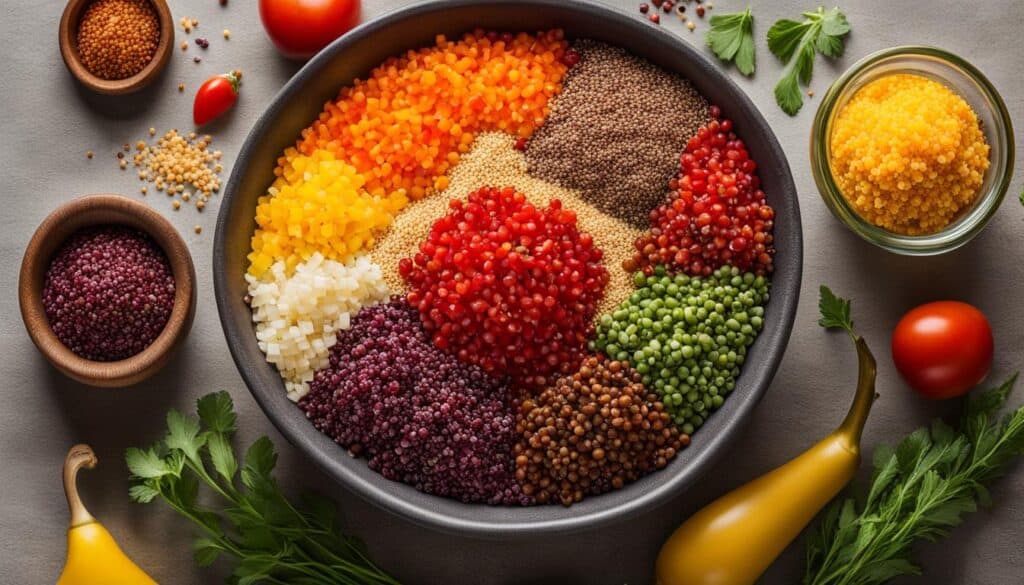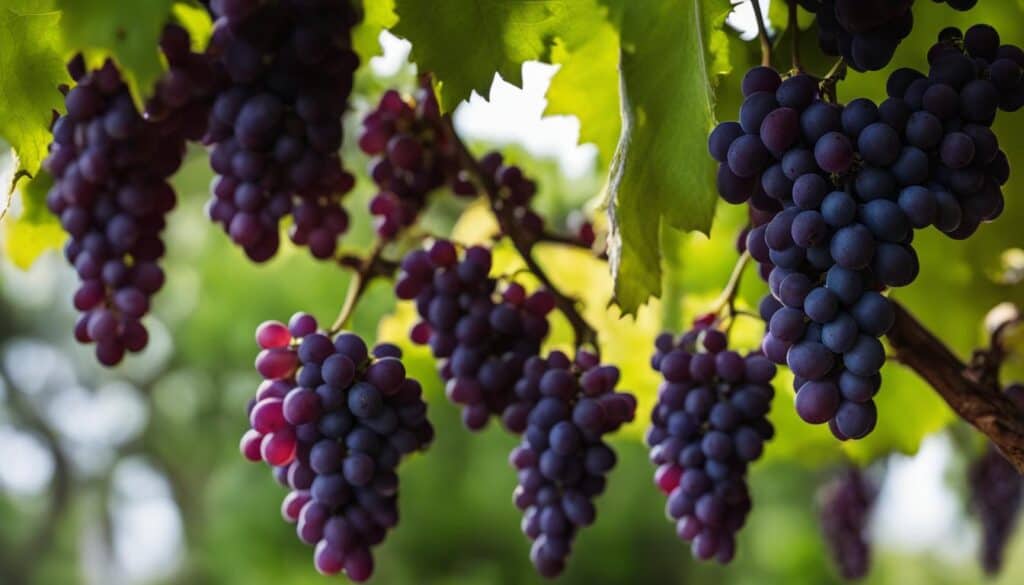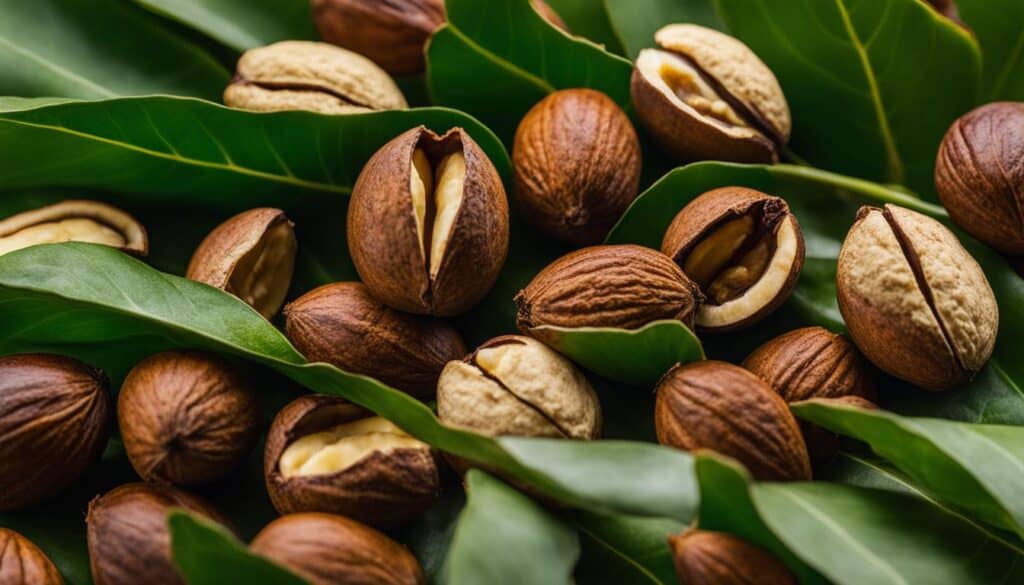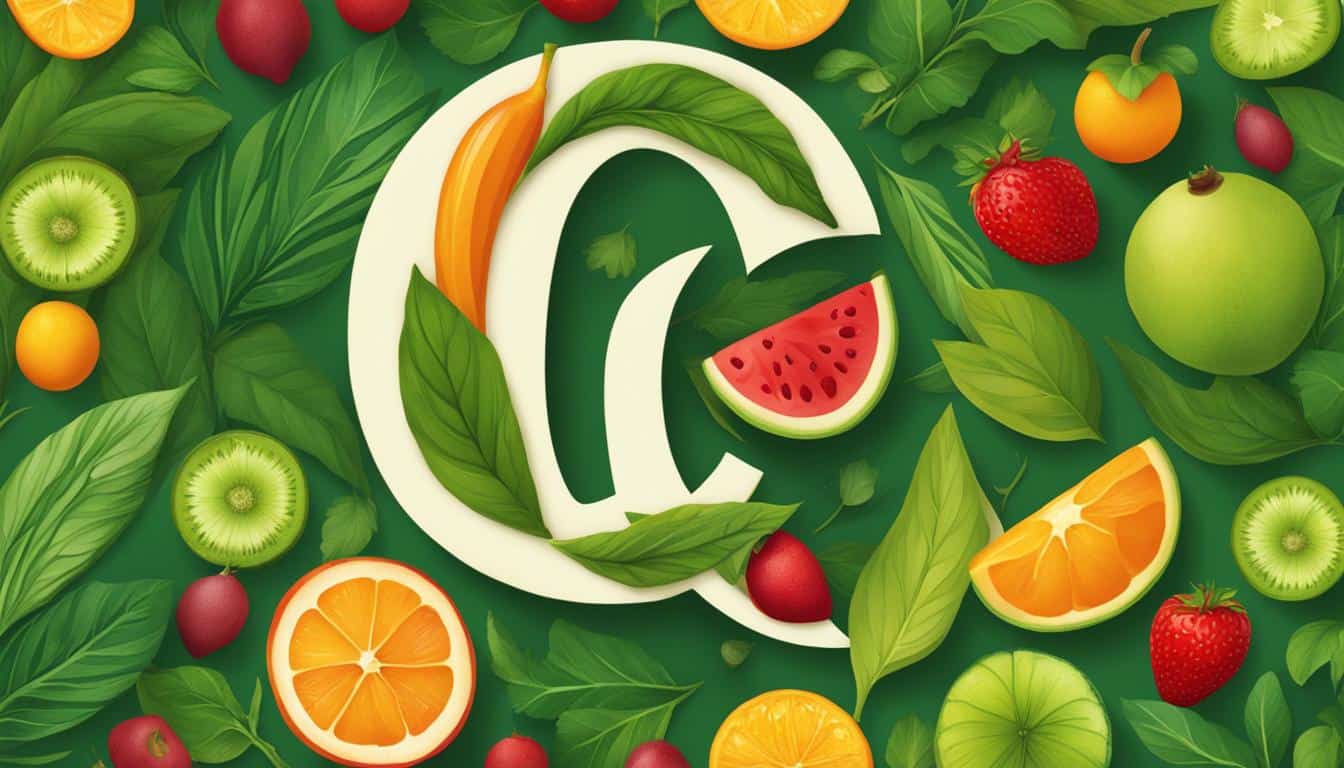Welcome to our exploration of fruits and vegetables that start with the letter Q! While it may seem challenging to find options in this category, we’ve gathered a variety of delicious and nutritious choices for you to discover. Let’s dive in and learn more about these unique ingredients.
Key Takeaways:
- Quince is a tart and yellow fruit commonly used in jams, jellies, and baked goods.
- Quinoa is a versatile grain high in protein, fiber, and other essential nutrients.
- Quenepa, quandong, Queen Anne cherry, and Queen Tahiti pineapple are lesser-known fruits with distinct flavors.
- Qarshi grape is a large and sweet variety often used in winemaking.
- Queensland nut, also known as macadamia nut, is a popular and nutritious nut.
Quince
Quince is a fruit that starts with the letter Q. It is a hard, yellow fruit with a tart flavor. Quince is often used in jams, jellies, and baked goods. It is native to Southwest Asia but is grown in many parts of the world. Quince is a good source of fiber, vitamin C, and antioxidants. It is also low in calories and fat. While quince is not commonly eaten raw due to its tartness and gritty texture, it can be cooked to soften and sweeten the fruit.
Nutritional Benefits of Quince
Quince is a nutritious fruit that offers several health benefits. It is a good source of dietary fiber, which can help promote digestive health and prevent constipation. Quince also contains vitamin C, which is important for boosting the immune system and supporting collagen production. Additionally, quince is rich in antioxidants, such as phenolic compounds, which can help reduce inflammation and protect against chronic diseases.
Uses of Quince
Quince is a versatile fruit that can be used in various culinary preparations. It is commonly used to make jams, jellies, and preserves due to its high pectin content. Quince can also be incorporated into baked goods like pies, tarts, and crumbles for a unique flavor. In Mediterranean cuisine, quince is often paired with meats like lamb or pork to create savory dishes. Overall, quince adds a distinct tangy and floral note to recipes, making it a prized ingredient in many culinary traditions.
Conclusion
Quince is a delicious and nutritious fruit that can be enjoyed in a variety of ways. Whether used in sweet or savory dishes, quince adds a unique flavor and texture that is sure to delight your taste buds. Incorporate quince into your culinary repertoire to experience the wonderful flavors and health benefits this fruit has to offer.
Quinoa: A Nutritious Grain That Starts With Q
Quinoa is a versatile grain that has gained popularity in Western diets due to its numerous health benefits. This gluten-free grain is not only delicious but also packed with essential nutrients. Quinoa is a complete protein source, meaning it contains all nine essential amino acids that our bodies need. It is also a good source of fiber, iron, magnesium, and vitamin B6.
One of the reasons quinoa is so beloved is its versatility in the kitchen. It can be used as a substitute for rice or pasta in a variety of dishes, such as salads, soups, and stir-fries. Its mild, nutty flavor adds a delightful taste to any meal.
Table: Nutritional Information of Quinoa
| Nutrient | Amount per 100g |
|---|---|
| Protein | 14g |
| Fiber | 7g |
| Iron | 2.8mg |
| Magnesium | 197mg |
| Vitamin B6 | 0.3mg |
“Quinoa is a nutritional powerhouse that should be a staple in any healthy diet. Its high protein content makes it a great choice for vegetarians and vegans. The fiber in quinoa helps with digestion and promotes a feeling of fullness, making it an excellent option for weight management.”
Incorporating quinoa into your diet is a simple and delicious way to boost your nutritional intake. Whether you’re looking for a grain alternative or want to try something new, quinoa is a fantastic choice that starts with the letter Q.

Quenepa: A Unique Fruit with a Sweet and Sour Flavor
If you’re looking for a unique and flavorful fruit that starts with the letter Q, look no further than quenepa. Also known as Spanish lime or mamoncillo, quenepa is a small green fruit with a hard outer shell and a soft, juicy interior.
Quenepa has a distinctive sweet and sour flavor that will tantalize your taste buds. It is often enjoyed fresh, simply by peeling off the outer shell and biting into the juicy flesh. The combination of sweetness and tartness makes quenepa a refreshing and satisfying snack.
The Health Benefits of Quenepa
In addition to its delicious taste, quenepa also offers several health benefits. It is a good source of vitamin C, which is essential for a healthy immune system. Quenepa is also rich in fiber, which aids in digestion and helps maintain a healthy weight.
Furthermore, quenepa is packed with antioxidants, which help protect your body against the damaging effects of free radicals. These antioxidants may have anti-inflammatory properties and can contribute to overall health and well-being.
A Versatile Fruit
Quenepa is not only enjoyed fresh but can also be used in a variety of culinary creations. Its sweet and sour flavor makes it a perfect ingredient for drinks, desserts, and even savory dishes. From quenepa smoothies to quenepa sorbet, the possibilities are endless when it comes to incorporating this unique fruit into your recipes.
So, if you’re looking to try something new and exciting, give quenepa a taste. Its delicious flavor and numerous health benefits make it a fruit worth exploring.
Quandong: A Tangy Fruit That Starts With Q
The quandong is a unique fruit that starts with the letter Q. It is a small, red fruit native to Australia and is found in arid and semi-arid regions of the country. Quandongs have a tart, slightly sour flavor that makes them stand out from other fruits. They are often used in the culinary world to make jams, jellies, and other preserves.
Not only do quandongs add a tangy twist to various dishes, but they also offer several nutritional benefits. They are a good source of vitamin C, which supports immune function and helps the body absorb iron. Quandongs are also rich in fiber, which aids digestion and promotes satiety. Additionally, they contain antioxidants that can help protect the body against damage from harmful free radicals.
Quandongs have a long history in Aboriginal medicine and are believed to have anti-inflammatory properties. They have been used to treat various ailments, including skin infections and digestive issues. While further research is needed to fully understand the potential health benefits of quandongs, they are a delicious and nutritious addition to any diet.
Tasty Quandong Recipe
Looking for a delicious way to enjoy quandongs? Try this simple recipe:
- Ingredients:
- 1 cup fresh quandongs, pitted and sliced
- 1 tablespoon honey
- 1/2 teaspoon cinnamon
- 1/4 cup rolled oats
- 1/4 cup sliced almonds
- Instructions:
- Preheat your oven to 350°F (175°C).
- In a baking dish, combine the sliced quandongs, honey, and cinnamon.
- In a separate bowl, mix the rolled oats and sliced almonds.
- Sprinkle the oat and almond mixture over the quandongs.
- Bake for 20-25 minutes, or until the topping is golden brown and the fruit is soft.
- Remove from the oven and let it cool slightly before serving.
This sweet and tangy dessert is perfect for showcasing the unique flavors of quandongs. Serve it warm with a dollop of whipped cream or a scoop of vanilla ice cream for an extra treat.
Queen Anne Cherry
The Queen Anne cherry is a delightful fruit that starts with the letter Q. This small, sweet cherry is known for its vibrant red color and juicy flesh. It is a popular choice for desserts and can be enjoyed fresh or used in various culinary creations. Queen Anne cherries are a good source of vitamin C, fiber, and antioxidants, making them a healthy and tasty addition to your diet.
Originating from various parts of the world, including the United States, Canada, and Europe, Queen Anne cherries are loved for their distinctive flavor and versatility. They can be used to make jams, preserves, pies, and even cocktails. Whether you’re enjoying them as a snack or incorporating them into your favorite recipes, Queen Anne cherries are sure to add a burst of sweetness to every bite.

| Health Benefits of Queen Anne Cherries |
|---|
| Rich in antioxidants, which help protect against oxidative stress and promote overall health |
| Good source of vitamin C, which supports immune function and collagen production |
| Contains dietary fiber, which aids in digestion and promotes feelings of fullness |
| Low in calories and fat, making them a guilt-free treat |
As you can see, Queen Anne cherries not only taste delicious but also offer numerous benefits for your health. So next time you’re looking for a fruity delight that starts with the letter Q, don’t forget to try these juicy and nutritious cherries.
Queen Tahiti Pineapple
Queen Tahiti pineapple is a delightful fruit that starts with the letter Q. With its larger size, golden-yellow flesh, and slightly oval shape, it is a standout among other pineapples. The Queen Tahiti pineapple is renowned for its sweet and juicy flavor, making it a popular choice for a variety of dishes, including desserts, smoothies, and tropical-inspired cuisine.

| Nutrient | Amount per 100g |
|---|---|
| Calories | 69 |
| Carbohydrates | 18g |
| Fiber | 2g |
| Protein | 1g |
| Fat | 0g |
| Vitamin C | 16mg |
| Potassium | 191mg |
| Antioxidants | High |
Source: USDA National Nutrient Database
Queensland Nut
The Queensland nut, also known as the macadamia nut, is a delicious fruit that starts with the letter Q. Native to Australia, it is known for its sweet and nutty flavor. The Queensland nut is often eaten roasted as a snack or used in a variety of culinary creations, including desserts, baked goods, and savory dishes.
This delectable nut is not only tasty but also packed with nutrients. It is a good source of healthy fats, including monounsaturated fatty acids, which have been linked to heart health. Queensland nuts are also rich in vitamins and minerals, such as vitamin B6, iron, and magnesium, which play important roles in supporting overall health and wellbeing.
Whether enjoyed on its own or incorporated into your favorite recipes, the Queensland nut adds a delightful crunch and flavor to any dish. So, next time you’re looking for a nutritious and delicious snack or ingredient, reach for the Queensland nut and savor its unique taste and health benefits.

Health Benefits of Queensland Nut:
- Rich in healthy fats, including monounsaturated fatty acids
- Good source of vitamins and minerals, such as vitamin B6, iron, and magnesium
- May support heart health
- Can be incorporated into a variety of recipes for added flavor and texture
Quettlebarb: A Unique Vegetable with a Tart and Sweet Flavor
The Quettlebarb is a rare and distinctive vegetable that starts with the letter Q. It is a cross between rhubarb and quince, combining the tartness of rhubarb with the subtle sweetness of quince. This unique combination of flavors makes the Quettlebarb a versatile ingredient that can be used in a variety of dishes.
One of the most popular uses for Quettlebarb is in pies and tarts. The tartness of the vegetable adds a delicious tang to sweet desserts, creating a perfect balance of flavors. Its versatility also extends to other desserts such as crumbles, cobblers, and even jams and preserves. When cooked down, the Quettlebarb releases its natural sweetness, making it an excellent choice for creating flavorful spreads.
Not only does the Quettlebarb offer a unique taste, but it also provides several health benefits. Like rhubarb and quince, it is a good source of fiber, vitamins, and antioxidants. The fiber content helps support healthy digestion, while the vitamins and antioxidants contribute to overall well-being. Incorporating Quettlebarb into your diet can be a delicious way to boost your nutrient intake.
Discover the Versatility of Quettlebarb
The Quettlebarb can be enjoyed in various ways, whether it’s in baked goods, spreads, or other culinary creations. Here are a few ideas to explore:
- Create a Quettlebarb pie or tart, combining the vegetable with other fruits for a delightful dessert.
- Make a Quettlebarb crumble by layering the vegetable with a sweet crumb topping.
- Cook down Quettlebarb with sugar and spices to create a flavorful jam or preserve.
- Experiment with savory dishes by adding Quettlebarb to chutneys, sauces, or even roasted vegetable medleys.
The versatility of Quettlebarb allows you to get creative in the kitchen and explore new flavors and combinations. Don’t be afraid to experiment and discover your favorite ways to incorporate this unique vegetable into your meals.
| Nutritional Information | Per 100g |
|---|---|
| Calories | 30 |
| Fiber | 4g |
| Vitamin C | 10mg |
| Antioxidants | High |
As seen in the table, the Quettlebarb is low in calories and high in fiber, making it a nutritious addition to your meals. Its vitamin C content and antioxidants further contribute to its health benefits.
The Quettlebarb is a unique vegetable that adds a delightful twist to both sweet and savory dishes. Its tart and sweet flavor profile, along with its versatility, make it a wonderful addition to any kitchen. Whether you’re a seasoned chef or an experimental home cook, the Quettlebarb is sure to inspire creativity in your culinary endeavors.
Quark: A Versatile Dairy Product
Quark is a dairy product that starts with the letter Q. It is similar to yogurt but has a thicker consistency and a slightly sour taste. Quark is popular in European countries and is often used in cooking and baking. It can be eaten on its own or used as a base for dips, spreads, and desserts. Quark is a good source of protein, calcium, and probiotics.
One of the unique characteristics of quark is its versatility. It can be used in both savory and sweet dishes, making it a versatile ingredient in the kitchen. Its thick and creamy texture makes it ideal for making creamy dips and spreads. It can also be used as a healthier alternative to cream cheese in recipes. Additionally, quark can be incorporated into desserts like cheesecakes and muffins, adding a tangy flavor and creamy texture.
Quark is also a nutritional powerhouse. It is rich in protein, which is essential for building and repairing tissues in the body. It also contains calcium, which is important for maintaining strong bones and teeth. Furthermore, quark is a good source of probiotics, which are beneficial bacteria that support gut health and digestion.
In summary, quark is a versatile dairy product that offers a range of culinary possibilities. Whether you’re looking to add creaminess to your savory dishes or a tangy flavor to your desserts, quark can be a delicious and nutritious addition to your recipes.
| Nutritional Content of Quark (per 100g) | Amount |
|---|---|
| Protein | 14g |
| Calcium | 120mg |
| Probiotics | Varies |
Conclusion
In conclusion, when it comes to fruits and vegetables that start with the letter Q, there are several options to choose from. Quince is a versatile fruit that can be used in jams, jellies, and baked goods, while quinoa is a nutritious grain that can be a great substitute for rice or pasta. Quenepa, quandong, Queen Anne cherry, and Queen Tahiti pineapple offer unique flavors that can liven up your palette.
Don’t forget about Qarshi grape, Queensland nut, Quettlebarb, and quark, which also provide delicious options and are packed with nutritional benefits. Whether you’re looking for a sweet or savory option, there’s something for everyone among these Q fruits and vegetables.
Adding these fruits and vegetables to your diet can help you increase your intake of vitamins, minerals, fiber, and antioxidants. So, why not give them a try and explore the wide range of flavors and textures they have to offer? Incorporating these Q foods into your meals can bring a culinary adventure to your plate.
From quince to quark, there are plenty of Q fruits and vegetables to discover. So go ahead and get creative in the kitchen with these unique and flavorful options. Whether you enjoy them raw, cooked, or in a delicious recipe, these Q foods are sure to add a touch of excitement to your meals.
FAQ
What is quince?
Quince is a hard, yellow fruit with a tart flavor. It is often used in jams, jellies, and baked goods.
Where is quince native to?
Quince is native to Southwest Asia.
What is quinoa?
Quinoa is a grain that is high in protein and can be used as a substitute for rice or pasta.
What are some other fruits and vegetables that start with Q?
Other fruits and vegetables that start with Q include quenepa, quandong, Queen Anne cherry, Queen Tahiti pineapple, Qarshi grape, Queensland nut, Quettlebarb, and quark.





Leave a Reply